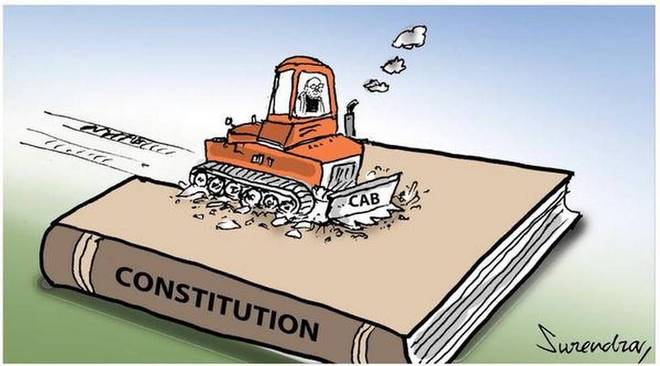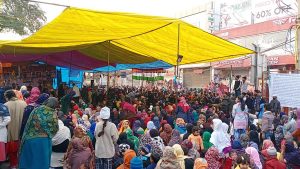On Human Rights Day, we might devote attention to the many groups that have been protesting against recent shifts in the understanding of “citizenship” in India. The Citizenship Amendment Bill, 2016, was designed to amend the Citizenship Act 1955 to recognize specific types of illegal immigrants, segregated by religion and country of origin. It was enacted on December 11, 2019 as the Citizenship (Amendment) Act, 2019 (CAA). Under the CAA Buddhists, Christians, Hindus, Jains, Parsis, and Sikhs who had migrated from Afghanistan, Bangladesh, or Pakistan to India prior to 2014 are no longer considered illegal immigrants and can more readily achieve citizenship. Left out of the six religions granted special privileges are Jews and Muslims, thereby making official a discriminatory policy against Islam and Judaism in India.

The Citizenship Amendment Act, 2016, breaks with India’s legacy of emphasizing secularism over religion nationally. Protests against the Citizenship Amendment Act had an early start in Northeast India (especially in Assam). A further impetus for protests is the expectation that with Muslims left out of the CAA, the all India National Register of Citizens (NRC) will find no place for Muslims but deem them stateless. This might occur even for those Muslims long resident in India.
Protests have been global, including an Open Letter to the Government of India drafted and signed by students, faculty, alumni and affiliates of Columbia University. The Ivy Plus Libraries Confederation has recently made public an Indian Citizenship Amendment Act Protest Movements Web Archive.
Along with news photos of global anti-CAA protests, political cartoons have illustrated the conflicts in India.

One common theme is the Muslim exclusionary aspect of the CAA. For example, Satish Acharya depicts Modi boasting “Historic day, India” while behind him someone has painted on the wall “Sabka saath, sabka vikas, sabka vishwas, minus Muslims” [support and trust everyone except Muslims]. Similarly, Aroop Mishra and Meghnad Bose published a dual panel cartoon in The Quint (9 Dec. 2019); the left panel depicts men holding signs reading “Welcome migrants” for ascetically dressed priests holding urns, while in the right panel the sign reads “Not Muslims” before a woman with a head shawl and a man with a skull cap. An article in The Print (21 Dec. 2019) brings together several cartoons on the theme of anti-CAA protests and internet shutdowns including an image of Mahatma Gandhi holding two balanced scales of protesters and policemen throwing stones at one another; another cartoon depicts Narendra Modi and Amit Shah looking at anti-CAA protesters through a window with Shah asking “Can’t we protest against [Jharkhand] exit polls?” PKMKB has selected and reprinted 10 “best of” CAA-NRC cartoons in a June 15, 2020 posting; my favorite of these is Shaheen Bagh’s Free Biryani, which depicts a woman about to ladle out portions of CAA from an urn labeled Modi’s biryani resting on a Shaheen Bagh fire (Shaheen Bagh was a female led anti-CAA protest rally), to various politically interested groups including the Aam Aadmi Party (AAP), the Congress, the Khalistan movement, the journalistic media, and others.
Background Reading
Dhoop, Prerna, “Citizenship (Amendment) Act: Enforcement Is Fraught with Legal Hurdles,” Economic & Political Weekly, Vol. 55, Iss. 4, January 25, 2020
Ivy Plus Libraries Confederation, “Indian Citizenship Amendment Act Protest Movements Web Archive”
Kundu, Amitabh & Mohanan, P. C., “Citizenship (Amendment) Act: How Do We Move Forward?,” Economic and Political Weekly, March 21, 2020
Nayak, Debasis, “Best of CAA-NRC Cartoons,” PKMKB, June 15, 2020
Nepram, Binalakshmi, “Manufacturing Citizenship: the Ongoing Movement Against Citizenship Amendment Bill in Northeast India,” Rightsviews, February 18, 2019
Parthasarathy, D., “Citizenship (Amendment) Act: The Pitfalls of Homogenising Identities in Resistance Narratives,” Economic & Political Weekly, Vol. 55, Iss. 25, June 20, 2020
Roy, Anupama, “The Citizenship (Amendment) Bill, 2016 and the Aporia of Citizenship,” Economic and Political Weekly, December 14, 2019
Roy, Anupama, Citizenship in India, New Delhi, India: Oxford University Press, 2016
Sarma, Chandan Kumar & Hazarika, Obja Borah, “Anti-CAA Protests and State Response in Assam: Identity Issues Challenge Hindutva-based Politics,” Economic & Political Weekly, Vol. 55, Iss 14, April 4, 2020
Solidarity Against CAA and NRC, “Open Letter to the Government of India,” December 18, 2019
Thakur, Apurva, “Why the Citizenship Amendment Bill Goes Against the Basic Tenets of the Constitution,” Economic & Political Weekly, Vol. 53, Iss. 13, March 31, 2018
Verghese, Leah & Narasappa, Harish, “Contestations Over Indian Citizenship: An Analysis of the Citizenship (Amendment) Bill, 2016,” National Law School of India Review, Vol. 31, Iss. 2: 157-176, 2019
Political Cartoon Examples
Mishra, Aroop and Bose, Meghnad, “Here’s What India Is Saying Through the Citizenship Amendment Bill,” The Quint, December 9, 2019
Satish Acharya cartoon, Citizenship Amendment Has Passed, sify.com
Sen, Soham, “Mahatma Gandhi on anti-CAA Protests & India’s “Global Leader” of Internet Shutdowns,” The Print, December 21, 2019
The Citizenship Amendment Act, 2016, breaks with India’s legacy of emphasizing secularism over religion nationally. Protests against the Citizenship Amendment Act had an early start in Northeast India (especially in Assam). A further impetus for protests is the expectation that with Muslims left out of the CAA, the all India National Register of Citizens (NRC) will find no place for Muslims but deem them stateless. This might occur even for those Muslims long resident in India.
I can’t believe this is happening!
Back to the dark ages. It’s a shame Bill which should have never been even considered. I hope common sense will prevail